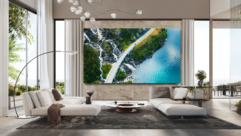
Five Ways to Make Your Home Theater Better Than the Rest
Jul 19, 2010 11:54 AM,
By Jason Bovberg

An elegant design creates warmth and comfort
There’s an article going around in home-theater circles called “The 20 Most Common Mistakes in the Home Cinema”. It’s from a site called Televisions.com, and it’s an effective listing of common mistakes that home theater enthusiasts make on, say, their first installation. There’s plenty of fantastic advice to be found in the article, but it sparked my own idea for a list.
While building my new home theater in my basement last year, I performed plenty of research, toured existing theaters, sought ideas from fellow enthusiasts, and spoke to installers and home builders. I got a ton of advice, and I incorporated suggestions in all areas—from cost-effective sound-absorption techniques to equipment choices. I had the ideal working relationship with my contractor, in which he fielded my ideas and needs, and showed me how to make them work—for a good price.
Related Links

Follow this basement home-theater makeover….

Real-world Projector Considerations
For my recent home-theater build, I decided to take the plunge into the front-projection market. …

I was talking to a friend the other day about the steady rise of Blu-ray in the home video market. …
Now that I’ve been enjoying my theater for more than a year, I thought I’d share the five aspects about it that I’m most proud of. These aren’t the kind of essential tips you’ll get from the aforementioned article, but rather detail-focused ideas that can make a theater special. These are the things that turned my theater into something perfect for my idea of an outstanding home cinema.
5) Give It an Elegant Design
One of the mistakes I made in my first theater, at my previous home, was to essentially divorce it from the rest of the house. It was a black little man-cave with poor decor and insufficient lighting. Hobbled by a low budget that leaned heavily toward equipment rather than the room’s design sense, I created a theater that provided a decent viewing experience once the lights went out but that was an embarrassment as a section of the home.
For that reason, design was on my mind when I developed my new theater. Working with an unfinished basement, I demanded that the new theater retain the look and style of the rest of the home—same alder moulding, same bullnose corners, same solid-core doors, and even a complementary color palette. In my research, the red-and-black tones I saw were the most striking, but to keep the flow with the rest of the home, I went with a rich chianti/chocolate combination that ended up giving the room a nice warmth. Add in well-thought-out details such as low-key but complementary sconces and dark, diamond-patterned, low-pile carpet, and the room had a modest wow factor—even with the lights on.

Easy access to equipment rack behind poster
4) Ensure Easy Access to the Back of Your Equipment Rack
I don’t know about you, but having easy access to the rear panels of my equipment—particularly my AV receiver, with its chaos of inputs and outputs and connections—is absolutely essential. As someone who enjoys his tech toys, I find myself trading out or bringing in new equipment of some sort every year. And let’s face it, sometimes a cable comes loose or a thread of a loudspeaker wire jostles free and makes contact where it shouldn’t, and suddenly your sound is out of whack.
An important aspect of my theater was to have that easy access. Of course, high-end home cinemas devote entire rooms to equipment, and rear access is as easy as walking behind the equipment. In my lower-budget scenario, I had to think more creatively. So in the build process, my framer and I designed a way for my existing equipment rack to assimilate into the new construction and provide access to it through an open space from the next room. The rear panel is simply covered with a sheet of sound board and a movie poster; when I need access, I just take down the poster.

3) Calibrate Your Image—and Not Just with a Pixar DVD
My perception is that more people seemed to care about proper image calibration with their DVD players and previous-generation, lower-resolution monitors than with their high-definition Blu-ray players and high-rez setups. Perhaps I’m imagining that disconnect, but I just remember more people talking about the importance of professional calibration or even a DVD calibration system such as Digital Video Essentials Blu-ray.
Digital Video Essentials offers a series of audio and video test signals that walk you through your home theater tune-up. Don’t take these seemingly arcane tests lightly: They can make the difference between a pretty good high-def image and an outstanding high-def image. And the audio tracks help you balance the sound in the room, giving the right weight to each individual loudspeaker as perceived from the listening position.
(Rumor has it that a series of test screens are available on all Sony Blu-ray discs, from a hidden menu. You can access them by pressing “7669” and “Enter” on your remote’s keypad while on the movie’s menu screen.)
2) Build a Completely Dark Room
Perhaps this will be a controversial suggestion, because people have different tastes or purposes in viewing environments: Some people think a home theater is a thing to be enjoyed as part of a larger entertainment area, and some people desire a more “pure” cinema experience. Count me among the latter. I often call my own theater a “screening room.” From the very beginning of the planning stages, I knew it would be a room with no ambient light—no windows to be found, no light pollution from other rooms, no distractions.
To me, that’s the very essence of a successful home theater: replicating the actual movie-theater experience. Which means, to accomplish it, you need a room that’s at least capable of becoming completely dark. Perhaps you might use mood-light sconces in this black room, even during a presentation, but you would retain mastery over such lighting. You’d have complete control over the room’s light—and if you have that, you have complete control over the quality of your video image, every time.

An acoustically transparent screen gives a theater a clean look.
1) Use an Acoustically Transparent Screen
Admittedly, this tip applies only to front-projection setups (which are becoming more popular in the high-def era), but one of the design elements I’m most happy with is the decision to use an acoustically transparent screen and place the center channel directly behind it. Obviously, this is the experience that most closely replicates that of an actual cinema, and there are other strong benefits: The hidden speaker gives your room a cleaner look, and the sound is coming from the most natural direction, where the action is taking place onscreen.
There are disadvantages with some of the older or cheaper transparent screens, including a small percentage of lost light through the screen. However, with some of the advances in microperforated and woven fabrics that some companies are using today, such loss is minimal. In my setup, I’ve performed tests comparing my transparent screen with non-transparent fabrics and have noticed no appreciable difference in brightness or sharpness. Check out the selections from Draper and Screen Research, and view their room-size and image-size recommendations for this type of screen. It might be a terrific choice for your theater—and that one extra detail that gives you that wow factor.
It’s in the Details
These are the details that made my theater a real thing of joy in my house. I urge you to do your research—and then do some more—before beginning construction. There are so many tiny and even budget-friendly details that you can incorporate into your design to take it to the next level. Do some brainstorming with all involved parties. Welcome conversations that begin with, “You know what would be really cool?” and then find a way to make those things work.









